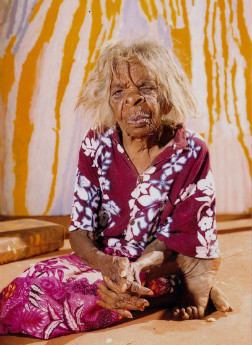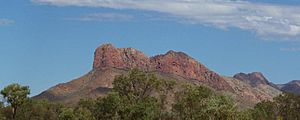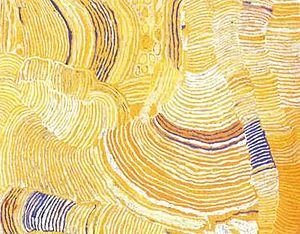Makinti Napanangka facts for kids
Quick facts for kids
Makinti Napanangka
|
|
|---|---|
 |
|
| Born | circa 1930 |
| Died | 9 January 2011 Alice Springs, Northern Territory, Australia
|
| Nationality | Australian |
| Known for | Painting |
|
Notable work
|
Untitled (Lupul rockhole) |
| Awards | 2008 National Aboriginal & Torres Strait Islander Art Award |
Makinti Napanangka (born around 1930 – died January 9, 2011) was an amazing Indigenous Australian artist. She came from the Pintupi people in Australia's Western Desert. After she passed away, people called her Kumentje. This is a special way to show respect in many Indigenous communities. They don't use a person's first name for a while after they die.
Makinti lived in different communities like Haasts Bluff, Papunya, and Kintore. Kintore is about 50 kilometers (31 miles) north-east of Lake MacDonald. This area is right on the border of the Northern Territory and Western Australia, where she was born.
Makinti Napanangka started painting in the mid-1990s. She was encouraged by a community art project in Kintore. People quickly became interested in her artwork. Now, her paintings are in many important Australian art galleries, including the National Gallery of Australia. Makinti was a finalist for a big art award in 2003. She then won the National Aboriginal & Torres Strait Islander Art Award in 2008. Her art was also shown in a major exhibition called Papunya Tula: Genesis and Genius at the Art Gallery of New South Wales.
Makinti used acrylic paint on linen or canvas. Her paintings often showed a special rockhole site called Lupul. She also painted stories about two sisters, known as Kungka Kutjarra, which are part of Indigenous "dreaming" stories. She was part of the Papunya Tula Artists Cooperative. However, her art style was often more free and natural than other artists in the group.
Contents
Makinti's Life Story

We don't know Makinti Napanangka's exact birth year. Most sources say she was born around 1930. Some say it could have been as early as 1922 or as late as 1932. Her birthplace is also a bit unclear. Some say it was Lupul rockhole, while others mention Mangarri. Everyone agrees she came from the Karrkurritinytja or Lake MacDonald area. This area is on the border of Western Australia and the Northern Territory. It's about 50 kilometers (31 miles) south-west of Kintore. It's also about 500 kilometers (310 miles) west of Alice Springs.
Makinti was part of the Pintupi people. This group is connected to communities like Papunya, Kintore, and Kiwirrkura. "Napanangka" is a "skin name". This is a special name used in the Pintupi family system. It's not like a last name that Europeans use. So, her personal name was "Makinti." It's hard to know exact birth dates and places for some Indigenous Australians. This is because they often estimate dates by comparing them to other events. This is especially true for people born before they met European Australians. They might also say a person was born where the mother first felt the baby move.
Makinti first saw white people riding camels when she lived at Lupul. In the early 1940s, she walked to Haasts Bluff with a large group of people. Her husband, Nyukuti Tjupurrula, and their son, Ginger Tjakamarra, were with her. Ginger was born around 1940. They had another child, Narrabri Narrapayi, in Haasts Bluff in 1949.
The family moved to Papunya in the late 1950s. Makinti had another child, Jacqueline Daaru, there in 1958. In 1961, she had a daughter, Winnie Bernadette, in Alice Springs. The family moved to Kintore when it was started in the early 1980s. By 1996, Makinti was painting there for the Papunya Tula Artists Cooperative. Her children Ginger, Narrabri, and Jacqueline also became artists. They all painted for Papunya Tula Artists.
Makinti was small but very strong. People described her as charming and having a strong personality. She always had a big, happy smile. She passed away in Alice Springs in January 2011.
Makinti's Art Career
Artists from the Papunya Tula movement were painting at Haasts Bluff in the late 1970s. But some main painters died in the early 1980s, and the art movement slowed down. In 1992, the Ikuntji Women's Centre opened at Haasts Bluff. A new painting movement quickly grew there. Marina Strocchi, an art coordinator, helped artists at both Haasts Bluff and Kintore.
This is how Makinti started painting in 1994. Her work was part of the Minyma Tjukurrpa (Kintore/Haasts Bluff Project). By 1997, major art places were buying her work. She was one of the "Kintore ladies" who joined the famous Papunya Tula artists. Other artists even called her "number one," seeing her as a leader. She painted with the Papunya Tula Artists Cooperative from 1996. She was a shareholder there, working alongside artists like Ningura Napurrula.
Makinti took a break from painting in 1999. She had an eye operation for cataracts. Some people believe this operation changed her art style. She started using thicker lines in her paintings. One journalist said her paintings became "light-flooded" after the operation. An art curator noted that her work showed "renewed vigor" after she recovered.
Makinti's artworks were chosen for five National Aboriginal and Torres Strait Islander Art Award (NATSIAA) exhibitions in a row. This started in 1997. In 2000, she had her first solo art show. Her art was also in the big exhibition Papunya Tula: Genesis and Genius. The next year, she was a finalist for the NATSIAA again.
From 2003 to 2006, Australian Art Collector magazine named her one of the country's 50 most collectible artists. In 2003, she was also a finalist for the Clemenger Contemporary Art Award. By 2006, her paintings were selling for high prices.
In August 2008, Makinti won the $40,000 NATSIAA award. She was too old to accept it in person. In October 2008, her paintings were part of a charity auction. The money raised helped the Menzies School of Health Research in Darwin. Her painting sold for A$18,500. This helped raise a lot of money for the charity.
In 2009, she was a finalist for the NATSIAA again. She was also a finalist for the Togart Contemporary Art Award that same year. In 2011, she was a finalist in the 36th Alice Art Prize. After she passed away in 2011, she was given the Member of the Order of Australia award. This was for her great work as an Indigenous artist. It also recognized her help for women painters in the Western Desert Art movement.
Most major Australian art collections have Makinti's work. These include the National Gallery of Australia and the Art Gallery of New South Wales. She was part of big group exhibitions. She also had a few solo shows at private galleries. The National Portrait Gallery has a photo of Makinti. Her work was chosen for the 2012 Sydney Biennale, a big art event.
Makinti's Painting Style
Makinti's paintings, including her award-winning works, were made with acrylic paint. She painted on linen or canvas.
Many Western Desert artists paint about water. A common story painted by Western Desert women is Kungka Kutjarra, or Two Women. This story is about two sisters traveling. Makinti's art often showed these themes. She especially painted about a rockhole site called Lupul and the Kungka Kutjarra story. Her painting in the Genesis and Genius exhibition was based on Kungka Kutjarra. The painting that won the 2008 Telstra award was about Lupul.
Her paintings used symbols like lines for paths and ceremonial hair-string skirts. Circles often showed water-holes.
Hetti Perkins, an art curator, said Makinti and her art were "very dynamic and charismatic." Even though Makinti was part of the Papunya Tula Artists, her work was more free and natural. It showed traditional symbols in a spontaneous way. Her style changed over time. At first, she used clear brush strokes in organized patterns. Later, her paintings showed more closely woven lines. These lines looked like hair-string skirts and body paint designs. Throughout her career, she often used soft yellows, pinks, oranges, and whites.
Judith Ryan, a curator at the National Gallery of Victoria, described Makinti's art as being about touch and feeling. She said the repeated colors and textures in Makinti's paintings were like many bodies dancing. They showed the deep, spiritual power of Makinti's land and culture. The energetic lines looked like body paint for women's ceremonies. They also showed spun hair-string. This string is used to make belts worn by women during ceremonies at the Lupulnga rockhole site.
Another art reviewer called Makinti's work "sensual and chromatically effusive." The "Kintore ladies" created art with rich textures. Makinti's painting for Genesis and Genius was celebrated for its color and form.
Major Art Collections
Makinti Napanangka's artwork can be found in many important collections:
- Art Gallery of New South Wales
- Campbelltown City Art Gallery
- Museum and Art Gallery of the Northern Territory
- National Gallery of Australia
- National Gallery of Victoria
- Queensland Art Gallery
- Macquarie Bank collection
- Shell Aboriginal Art Fund Collection
- Kluge-Ruhe Aboriginal Art Collection of the University of Virginia
Awards and Exhibitions
- 1997 – 14th National Aboriginal & Torres Strait Islander Art Award
- 1998 – 15th National Aboriginal & Torres Strait Islander Art Award
- 1999 – 16th National Aboriginal & Torres Strait Islander Art Award
- 2000 – 17th National Aboriginal & Torres Strait Islander Art Award
- 2000 – Solo show at Utopia Art, Sydney
- 2001 – Finalist, 18th National Aboriginal & Torres Strait Islander Art Award
- 2001 – Solo show at Utopia Art, Sydney
- 2002 – Solo show at Gallery Gabrielle Pizzi, Melbourne
- 2003 – Solo show at Utopia Art, Sydney
- 2003 – Finalist, Clemenger Contemporary Art Award at the National Gallery of Victoria
- 2007 – Finalist, 24th National Aboriginal & Torres Strait Islander Art Award
- 2008 – Winner, 25th National Aboriginal & Torres Strait Islander Art Award
See also
 In Spanish: Makinti Napanangka para niños
In Spanish: Makinti Napanangka para niños


